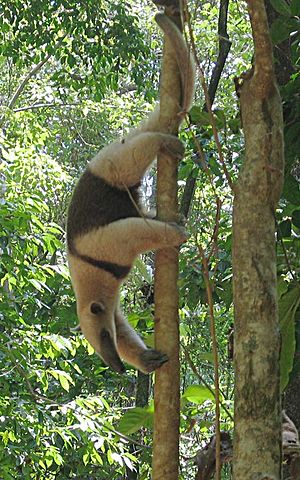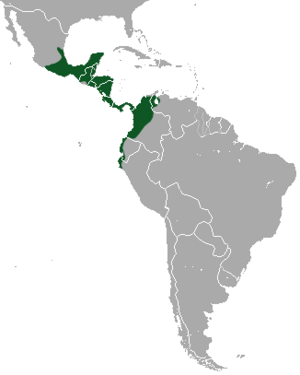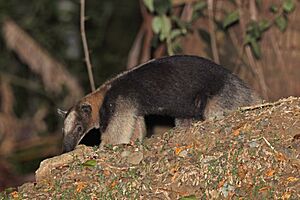Northern tamandua facts for kids
Quick facts for kids Northern tamandua |
|
|---|---|
 |
|
| Conservation status | |
| Scientific classification | |
| Genus: |
Tamandua
|
| Species: |
mexicana
|
 |
|
| Northern tamandua range | |
The northern tamandua (Tamandua mexicana) is a cool type of tamandua. It's a kind of anteater that belongs to the Myrmecophagidae family. These amazing animals live in warm, wet forests. You can find them from southern Mexico all the way through Central America. They also live near the northern Andes mountains.
Contents
About the Northern Tamandua
The northern tamandua is a medium-sized anteater. It has a special tail that can grab things, like a monkey's tail. This is called a prehensile tail. It also has small eyes and ears, and a long nose.
Most of its fur is light yellow. But it has a unique black patch of fur on its sides, back, and shoulders. This patch looks a bit like a vest! Its tail has fur for about one-third of its length. The rest of the tail is bare. Its back feet have five toes, but its front feet only have four.
Male and female tamanduas look very similar. They are also about the same size. They can be from 102 to 130 centimeters (about 40 to 51 inches) long. This includes their tail, which is 40 to 68 centimeters (about 16 to 27 inches) long. Adult tamanduas weigh between 3.2 and 5.4 kilograms (about 7 to 12 pounds).
How Northern Tamanduas Are Different
The northern tamandua looks a lot like its cousin, the southern tamandua. Northern tamanduas always have that black vest pattern. But southern tamanduas can look very different depending on where they live. Some southern tamanduas are all pale, some have a partial vest, and some are dark.
Sometimes, southern tamanduas can even have the same black vest as northern tamanduas. When this happens, it's harder to tell them apart. Scientists then look at their size, ear length, skull shape, and the number of bones in their tail. Also, the two species live in different areas, so their locations help tell them apart.
Special Body Parts
Like other anteaters, the northern tamandua has a body built for its special diet. Its tongue is very long and can stretch out far. It's covered in sticky saliva, which helps it pick up ants and termites.
This tongue has very strong muscles. These muscles are connected to a large bone in its throat. They even connect to the top of its chest bone! Its whole mouth is shaped to hold this long tongue. It's so long that the back of its mouth goes almost to its neck.
The northern tamandua's jaw muscles are small, and its jawbone is quite delicate. Just like other anteaters, the northern tamandua has no teeth at all!
Climbing and Digging
Unlike the giant anteater, the northern tamandua is also good at climbing trees. Its toe muscles and tough pads on its palms help its front feet grab onto things. This makes them great for climbing.
The middle toe on its front feet has a very large claw. This claw is strong enough to rip open wood. This helps the tamandua get to the ants and termites hiding inside.
Where Northern Tamanduas Live
Northern tamanduas live in forests from southern Mexico through Central America. Their range extends to western Colombia, Venezuela, and Ecuador. You can also find them in the northwestern part of Peru.
They live in many kinds of forests in these areas. This includes forests that stay green all year, forests where trees lose their leaves, and even mangrove swamps. They also live in cloud forests and forests that have grown back after being cut down.
Scientists recognize four different types, or subspecies, of T. mexicana:
- T. m. mexicana - Found in Mexico, Guatemala, Belize, Honduras, and El Salvador.
- T. m. instabilis - Found in Venezuela and northern Colombia.
- T. m. opistholeuca - Found in Nicaragua, Costa Rica, Panama, and most of Colombia.
- T. m. punensis - Found in Ecuador and Peru.
Northern Tamandua Behaviour
Northern tamanduas are mostly active at night. But they can also be seen moving around during the day. They spend about 40% of their time up in trees. They are active for about eight hours each day. The rest of the time, they rest inside hollow trees.
These animals live alone. Each tamandua has its own home area, which can be between 25 and 70 hectares (about 62 to 170 acres). Big cats like jaguars and large birds like harpy eagles sometimes hunt them.
What They Eat
Northern tamanduas eat almost only ants and termites. Sometimes, they might eat a small amount of fruit. They prefer bigger insects, more than 4 millimeters (about 0.16 inches) long. This includes types of ants like Camponotus and Azteca.
They can eat up to 9,000 insects in one day! They visit 50 to 80 different insect nests. They find these nests using their excellent sense of smell. Then, they dig into the nests with their strong claws. They use their long, sticky tongues to slurp up the insects. They don't seem to hurt the nests too much. This might be because they don't stay long at each nest. The insects' natural defenses probably drive them away quickly.
Communication and Defense
Tamanduas can talk to each other by leaving scent marks. They do this using special scent glands near their tail. Baby tamanduas can be quite noisy, but adult tamanduas rarely make any sounds.
If a tamandua feels threatened, it can stand up on its back legs and tail. It might lean against a tree or rock for support. Then, it can lash out with its sharp claws to defend itself.
Northern Tamandua Reproduction and Life Cycle
Northern tamanduas don't have a specific breeding season. Females can become ready to have babies at any time of the year. Males find females that are ready to mate by using their sense of smell. They will sniff and gently swat the female with their claws.
When they mate, the male uses his strong front legs and tail to hold the female. Pregnancy lasts from 130 to 190 days. After this, the female gives birth to just one baby. The young tamandua first stays in a nest inside a hollow tree. Later, it rides around by clinging to its mother's back.
Young tamanduas leave their mother when they are about one year old. In zoos, northern tamanduas have been known to live for up to 9.5 years.



